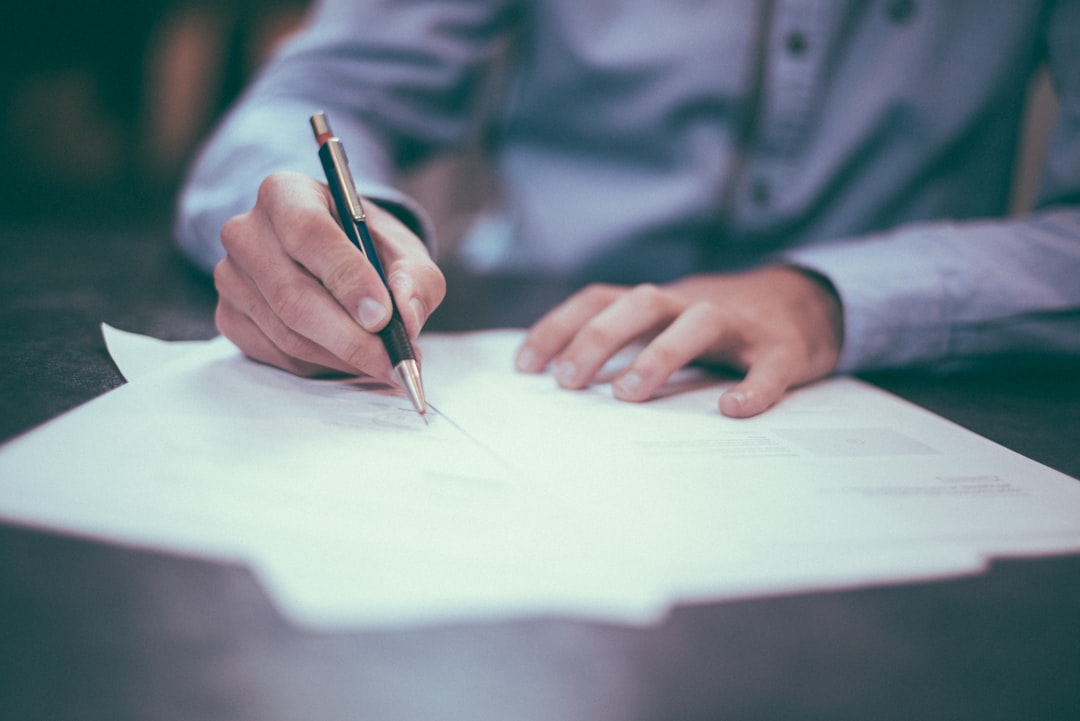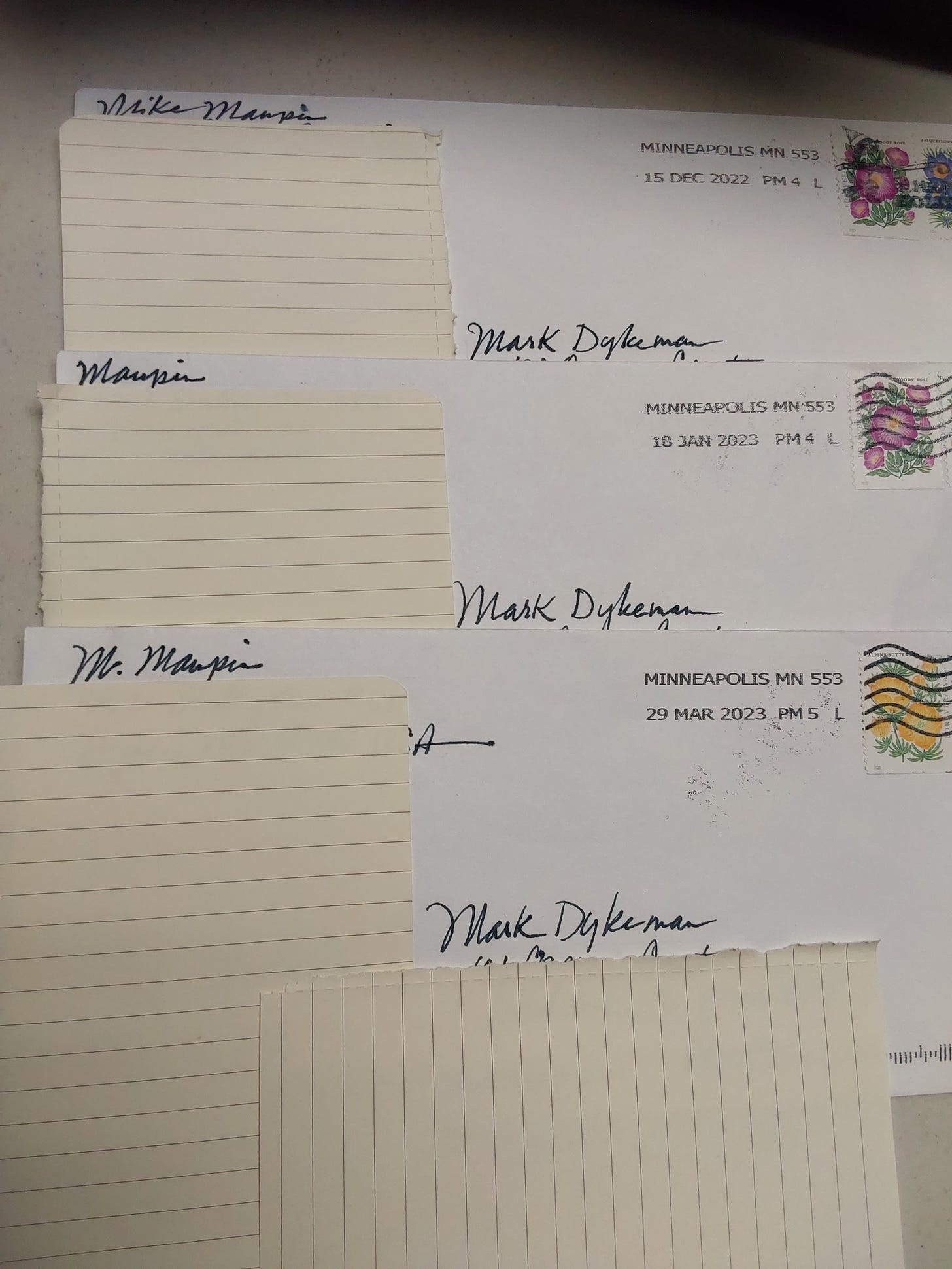
I used to write and receive a lot of letters via postal mail but that was over 30 years ago (three centuries ago by the way we currently measure technological progress). Meanwhile if I send less than 20 work emails per day, not including online messaging, etc. then half of my work colleagues must be on holidays. But older ways still have value.
A few months ago I was approached by
of to see if I’d like to participate in a letter exchange. Substack Letters had recently debuted as a way for writers to discuss topics over a series of “letters”, i.e. newsletter posts. Mike’s idea was for us to handwrite a series of letters and exchange them by postal mail. Plus we could use our fountain pens just for fun. With no firm guidelines I started with the first letter and we exchanged three letters apiece.[For an example of Substack Letters posts as intended, please check out my Letters exchanged with - On Process and Place.]
The process of exchanging the letters took a lot longer than either of us expected. We started in mid December and found, somewhat to my disgust, that it took two weeks for a letter to travel from Woodstock, NB to Minneapolis, MN. That pesky border! There was a big gap between our second and third letters as I was caught up in a lot of other things and so I spent the minimum time possible on letter writing. Alas.
I got Mike’s last letter near the end of March and I was slow to move forward to the next step. But finally we’re here!
Mike is writing his own newsletter post (here it is) reflecting on the experience. Here are my thoughts on at least temporarily having a pen pal once again.
In my first letter I told Mike about my pen pal days when I was a teenager in the mid to late 1980s. I used to receive letters, audio and video cassettes from friends and acquaintances which helped lay the foundations for my love of science fiction and fantasy in all forms plus music and gaming. In his first reply I learned that Mike would have liked to have lived in small towns like I did, his parents had to “follow the money” and live in or near cities. Ironically enough, I learned that Mike is 9 - 10 years older than me, which was also true of one of my closest pen pals back in the day, a guy who lived in or near NYC.
I agreed wholeheartedly with one of Mike’s comments in the first letter:
Seeing something sent to you personally, written by hand, has the visual appeal of a hug - that hasn’t changed. It’s difficult to reproduce that warmth via Web 1.0.
Indeed, it’s difficult to replicate the experience of receiving, opening and reading a letter in any digital media.
By the time the second letter appeared we discussed our careers and, more specifically where we worked. I spent almost all of the COVID-19 period working from home (mid March 2020 through to October 2022), with a shift to “regular” hybrid work from November 2022 onward. In contrast, Mike had to shift to work from home due to some office changes with his employer. I don’t think Mike was terribly enthused with the idea of spending more time at home. For me, the return of working onsite even for a couple of days per week was an adjustment but it feels much more natural now, even if I do spend more money on gasoline.
We also talked about how we would occasionally receive letters from one or more of our grandparents. I used to get a couple of letters per year from my father’s mother. I could never figure out if my grandmother was engaging in wishful thinking about my brother and I attending church regularly and participating in activities there (we were so NOT doing that) or if she was hinting that we needed to do that. Good times. My grandmother (my father’s mother) passed away over thirty years ago; I never got to know her as an adult. Her husband (my father’s father, the one who established a tradition of using the name Andrew in our family line)1 passed away when I was only one year old so I never got to know him at all. That’s one of my biggest regrets, although I fear we would not have really had much to say to each other, coming from such different eras (he was born in 1893).
Our third letter to each other was one of wrapping things up and trying to figure out where to go next. We talked a bit about pen and ink preferences (I’ve developed a taste for blue-black ink as a result of this letter series) and wound things up.
I enjoyed receiving letters in the mail again, like when I was much younger - letters were an important way to stay informed in the pre World Wide Web world when the Internet was much, much smaller. I think this previous letter writing experience helped me to adopt social media fairly easily because I was used to corresponding with people who lived hundreds or thousands of miles away.
These days we have high expectations for fast delivery of everything. It’s harder today to replicate the experience of ordering something and having to wait FOREVER to receive it in the mail:
You’d mail your order (if you were really lucky and didn’t mind the costs in some cases you could phone it in)
In the pre Amazon era it could take weeks to pick and pack an order for shipment
Then the long wait to receive your goods
People get irritable if it takes more than 2 - 3 business days to receive something these days. Which is understandable because our expectations are much higher in the 21st century with the advances made in logistics and information technology. But we’ve lost most of the opportunities for anticipation and excitement that come from having to wait to receive something and knowing that it could be coming from a long way away. Letters were no different.
We’re so dependent on the rapid flipping of electrons and bytes for our professional and personal lives that only a significant catastrophe would ever return us to the slower pace of correspondence from the mid to late 20th century. But with quantity and speed comes commoditization: how emotionally rewarding are most emails compared to most letters? Personal correspondence is fast and simple these days but it seems less precious now because of the ubiquitous presence of electronic communication. Many people just seem to spew out their surface thoughts in a few minutes and click Send as quickly as possible so they can get on to the next thing. How many of us really take the time to plan and write a lengthy, detailed personal email these days? Probably fewer and fewer as younger generations are generally not exposed to letter writing, using texting, chat and social media posts instead. And those of Gen X and earlier generations have been pulled into these new ways, too.
But letter writing is still there and it still has some of the old magic - Mike and I proved it!
This was a fun exchange of thoughts and I’m glad Mike suggested it. It might also be fun to develop some new pen pals, with or without paper. There’s a definite time and emotional investment needed to have meaningful correspondence but I think it’s quite worth it.
One thing that I didn’t expect was that I would feel sad remembering some of the people who I used to exchange letters with: a number of them are no longer alive and I miss them, even if we didn’t remain close. Bug or feature: still not sure. But it’s still important to remember the departed, lest they really do disappear from memory as well.
Once again, thank you Mike for suggesting this experience and seeing it through with me. It was fun and it reminded me of the importance of the written word and indeed the paper letter.
Over to you: do you correspond regularly with friends or family, on paper or electronically? Did you at one time and do you regret falling out of the habit? Please share your thoughts in the Comments section!
Grandfather’s middle name was Andrew, as is mine and my father’s. I disrupted this tradition slightly in the 4th generation by naming my son Andrew David but I actually brought back an older tradition because my great-grandfather Dykeman and his father were both named David. So there.




I’d be delighted to correspond with ppl via post again.
Great newsletter! When the pandemic began in 2020 I started mailing postcards to friends. Often these cards had my artwork on them. I still mail postcards now. Perhaps at less volume than I did during the lockdown days.